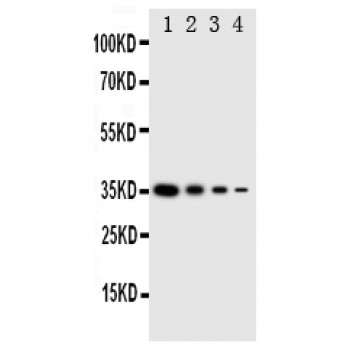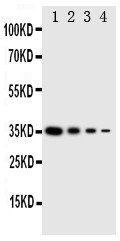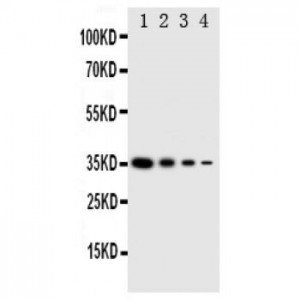More info
Overview
Long Name | Antibody Type | Antibody Isotype | Host | Species Reactivity | Validated Applications | Purification |
| eukaryotic translation initiation factor 2-alpha kinase 2 | Polyclonal | IgG | Rabbit | Human | WB | Immunogen affinity purified. |
Immunogen | ||||||
| A synthetic peptide corresponding to a sequence at the N-terminus of human PKR(2-18aa AGDLSAGFFMEELNTYR). | ||||||
Properties
Form | Lyophilized |
Size | 100 µg/vial |
Contents | Antibody is lyophilized with 5 mg BSA, 0.9 mg NaCl, 0.2 mg Na2HPO4, 0.05 mg Thimerosal and 0.05 mg NaN3. *carrier free antibody available upon request. |
Concentration | Reconstitute with 0.2 mL sterile dH2O (500 µg/ml final concentration). |
Storage | At -20 °C for 12 months, as supplied. Store reconstituted antibody at 2-8 °C for one month. For long-term storage, aliquot and store at -20 °C. Avoid repeated freezing and thawing. |
Additional Information Regarding the Antigen
Gene | EIF2AK2 |
Protein | Interferon-induced, double-stranded RNA-activated protein kinase |
Uniprot ID | P19525 |
Function | IFN-induced dsRNA-dependent serine/threonine-protein kinase which plays a key role in the innate immune response to viral infection and is also involved in the regulation of signal transduction, apoptosis, cell proliferation and differentiation. Exerts its antiviral activity on a wide range of DNA and RNA viruses including hepatitis C virus (HCV), hepatitis B virus (HBV), measles virus (MV) and herpes simplex virus 1 (HHV-1). Inhibits viral replication via phosphorylation of the alpha subunit of eukaryotic initiation factor 2 (EIF2S1), this phosphorylation impairs the recycling of EIF2S1 between successive rounds of initiation leading to inhibition of translation which eventually results in shutdown of cellular and viral protein synthesis. Also phosphorylates other substrates including p53/TP53, PPP2R5A, DHX9, ILF3, IRS1 and the HHV-1 viral protein US11. In addition to serine/threonine-protein kinase activity, also has tyrosine-protein kinase activity and phosphorylates CDK1 at 'Tyr-4' upon DNA damage, facilitating its ubiquitination and proteosomal degradation. Either as an adapter protein and/or via its kinase activity, can regulate various signaling pathways (p38 MAP kinase, NF-kappa-B and insulin signaling pathways) and transcription factors (JUN, STAT1, STAT3, IRF1, ATF3) involved in the expression of genes encoding proinflammatory cytokines and IFNs. Activates the NF-kappa-B pathway via interaction with IKBKB and TRAF family of proteins and activates the p38 MAP kinase pathway via interaction with MAP2K6. Can act as both a positive and negative regulator of the insulin signaling pathway (ISP). Negatively regulates ISP by inducing the inhibitory phosphorylation of insulin receptor substrate 1 (IRS1) at 'Ser- 312' and positively regulates ISP via phosphorylation of PPP2R5A which activates FOXO1, which in turn up-regulates the expression of insulin receptor substrate 2 (IRS2). Can regulate NLRP3 inflammasome assembly and the activation of NLRP3, NLRP1, AIM2 and NLRC4 inflammasomes. Can trigger apoptosis via FADD-mediated activation of CASP8. Plays a role in the regulation of the cytoskeleton by binding to gelsolin (GSN), sequestering the protein in an inactive conformation away from actin. |
Tissue Specificity | Highly expressed in thymus, spleen and bone marrow compared to non-hematopoietic tissues such as small intestine, liver, or kidney tissues. Colocalizes with GSK3B and TAU in the Alzheimer disease (AD) brain. Elevated levels seen in breast and colon carcinomas,and which correlates with tumor progression and invasiveness or risk of progression. |
Sub-cellular localization | Cytoplasm. Nucleus. Cytoplasm, perinuclear region. Note: Nuclear localization is elevated in acute leukemia, myelodysplastic syndrome (MDS), melanoma, breast, colon, prostate and lung cancer patient samples or cell lines as well as neurocytes from advanced Creutzfeldt-Jakob disease patients. |
Sequence Similarities | Belongs to the protein kinase superfamily. Ser/Thr protein kinase family. GCN2 subfamily. |
Aliases | double stranded RNA activated protein kinase; antibody|E2AK2_HUMAN antibody|eIF-2A protein kinase 2 antibody|EIF2AK1 antibody|EIF2AK2 antibody|Eukaryotic translation initiation factor 2 alpha kinase 2 antibody|Eukaryotic translation initiation factor 2-alpha kinase 2 antibody|eukaryotic translation initiation factor 2-alpha kinase antibody|HGNC:9437 antibody|Interferon induced double stranded RNA activated protein kinase antibody|Interferon inducible elF2 alpha kinase antibody|Interferon inducible RNA dependent protein kinase antibody|Interferon inducible RNA-dependent protein kinase antibody|Interferon-induced, double-stranded RNA-activated protein kinase antibody|Interferon-inducible RNA-dependent protein kinase antibody|MGC126524 antibody|P1/eIF-2A protein kinase antibody|P1/eIF2A protein kinase antibody|p68 kinase antibody|PKR antibody|PRKR antibody|Protein kinase interferon inducible double stranded RNA dependent antibody|Protein kinase RNA activated antibody|Protein kinase RNA-activated antibody|Serine/threonine protein kinase TIK antibody|Serine/threonine-protein kinase TIK antibody|Tyrosine protein kinase EIF2AK2 antibody |
Application Details
| Application | Concentration* | Species | Validated Using** |
| Western blot | 0.1-0.5μg/ml | Human | AssaySolutio's ECL kit |
AssaySolution recommends Rabbit Chemiluminescent WB Detection Kit (AKIT001B) for Western blot. *Blocking peptide can be purchased at $65. Contact us for more information

Anti-PKR antibody, ASA-B1538, Western blotting
Recombinant Protein Detection Source: E.coli derived -recombinant Human EIF2AK2, 35.0KD(162aa tag+ M1-K154)
Lane 1: Recombinant Human EIF2AK2 Protein 10ng
Lane 2: Recombinant Human EIF2AK2 Protein 5ng
Lane 3: Recombinant Human EIF2AK2 Protein 2.5ng
Lane 4: Recombinant Human EIF2AK2 Protein 1.25ng
Recombinant Protein Detection Source: E.coli derived -recombinant Human EIF2AK2, 35.0KD(162aa tag+ M1-K154)
Lane 1: Recombinant Human EIF2AK2 Protein 10ng
Lane 2: Recombinant Human EIF2AK2 Protein 5ng
Lane 3: Recombinant Human EIF2AK2 Protein 2.5ng
Lane 4: Recombinant Human EIF2AK2 Protein 1.25ng



